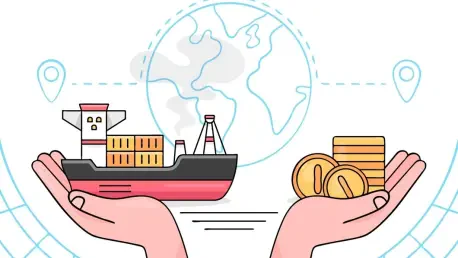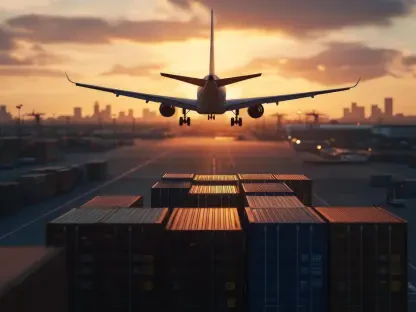Setting the Stage: Asia Pacific’s Unyielding Trade Momentum
Amidst a backdrop of geopolitical friction and economic policy turbulence, the Asia Pacific region stands as a powerhouse in global trade, driving growth at a pace unseen in over a decade. With trade volumes surging and regional networks tightening, this area has become a focal point for businesses seeking stability in uncertain times. This market analysis aims to dissect the forces propelling Asia Pacific to the forefront of international commerce, leveraging comprehensive data to uncover trends, challenges, and future outlooks. The importance of this examination lies in understanding how the region navigates external pressures, such as tariff hikes from major economies like the U.S., while capitalizing on internal strengths. By delving into these dynamics, stakeholders can better position themselves in a rapidly evolving global marketplace.
Deep Dive into Market Trends and Projections
Unraveling the Surge in Trade Volumes
The Asia Pacific region has demonstrated remarkable vigor in sustaining trade growth despite global economic headwinds. Data from recent global connectedness studies reveal that trade in the first half of this year reached its highest growth rate since 2010, excluding post-pandemic recovery periods, with Asia Pacific economies leading the charge. Notably, six of the ten fastest-expanding trade lanes originate from Asian markets, showcasing the region’s pivotal role in supply chains. Countries such as Hong Kong SAR, Thailand, Malaysia, and Vietnam rank among the top ten globally for trade value increases, driven in part by preemptive importing to circumvent anticipated tariff escalations from key markets like the U.S.
This surge, while impressive, comes with inherent risks tied to policy unpredictability. The reliance on short-term demand spikes from external markets could pose challenges if protectionist measures tighten further. However, the adaptability of Asian businesses in capitalizing on these windows of opportunity highlights a strategic acumen that sets the region apart. Looking ahead, sustained growth will depend on balancing these short-term gains with long-term diversification to mitigate exposure to single-market dependencies.
The Power of Intra-Regional Trade Networks
A significant trend shaping Asia Pacific’s trade landscape is the deepening of intra-regional connections, which serve as a buffer against external volatilities. The proportion of intra-regional trade within East Asia & Pacific has edged up to 56%, reflecting a strategic shift toward closer economic ties among neighboring countries. This movement is further evidenced by shorter trade distances in nations like Thailand, China, Singapore, and Hong Kong SAR, facilitated by enhanced infrastructure and streamlined connectivity, making regional trade more efficient and cost-effective.
This inward focus offers a layer of insulation from global policy shifts, as seen in the redirection of exports within the region. For instance, a notable decline in shipments to traditional markets like the U.S. has been offset by increased trade with nearby economies, particularly within Southeast Asia. While this trend fosters resilience, it also raises concerns about potential over-reliance on regional partners, which could limit global diversification. Projections suggest that continued investment in cross-border infrastructure will be crucial to maintaining this momentum over the next few years, potentially solidifying Asia Pacific as a self-reliant trade bloc.
ASEAN’s Ascendance as a Trade Epicenter
Central to Asia Pacific’s evolving trade narrative is the rising influence of the Association of Southeast Asian Nations (ASEAN), which has emerged as a critical hub in global supply chains. As certain major exporters reorient their strategies amid declining demand from Western markets, ASEAN countries like Vietnam, Thailand, and India have absorbed significant trade volumes, particularly from China. This shift underscores ASEAN’s growing importance as a destination for redirected exports, with data indicating a balanced trade increase matching declines in other regions.
Despite this progress, disparities in infrastructure and regulatory frameworks across ASEAN member states present ongoing challenges to seamless integration. Addressing these gaps through targeted investments and policy harmonization could amplify the bloc’s global standing. Market forecasts indicate that ASEAN’s role will likely expand further by 2027, potentially redefining trade patterns if collaborative efforts continue to strengthen. This development positions the region as a proactive force, countering any notion of merely reacting to external pressures.
Emerging Innovations and Future Market Shifts
Looking toward the horizon, technological advancements and policy evolution are set to redefine Asia Pacific’s trade landscape. Digital logistics platforms and AI-driven supply chain optimizations are gaining traction, enhancing operational efficiencies across borders. Major logistics players are investing heavily in these technologies to support regional growth, signaling a broader trend of digitization that could lower costs and improve trade agility in the coming years.
Economically, the sustained rise of intra-Asia trade may reduce dependence on traditional Western markets, creating a more balanced global trade structure. Regulatory changes, particularly within ASEAN, could further encourage integration if trade-friendly policies are prioritized. Analysts anticipate that even if global protectionist tendencies escalate, Asia Pacific might accelerate the development of alternative trade ecosystems, potentially establishing itself as an independent economic powerhouse by the end of the decade. Such projections highlight the region’s capacity to innovate under pressure, shaping a future where adaptability remains a core strength.
Reflecting on Insights and Charting the Next Steps
This analysis of Asia Pacific’s trade performance reveals a region that navigates global uncertainties with unparalleled resilience, leveraging robust growth, intra-regional collaboration, and ASEAN’s rising prominence to lead international commerce. The data paints a picture of sustained momentum, with trade volumes hitting record highs and regional networks providing a critical safety net against external shocks. These findings underscore the enduring strength of globalization, even as policy challenges persist.
Moving forward, businesses are advised to prioritize diversification within Asian markets to hedge against tariff-related risks, tapping into high-growth areas like Vietnam and Thailand for emerging opportunities. Partnering with logistics experts to streamline operations proves essential in maintaining competitiveness amidst shifting dynamics. Additionally, embracing technological innovations in supply chain management offers a pathway to enhance efficiency, ensuring agility in a volatile environment. These strategic steps, grounded in the lessons of Asia Pacific’s success, provide a roadmap for stakeholders to thrive in an ever-changing trade landscape.









